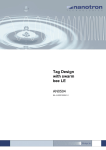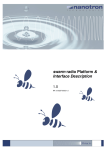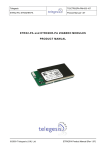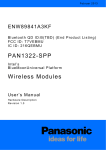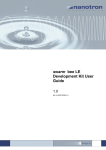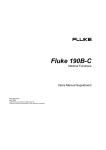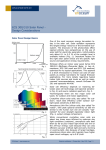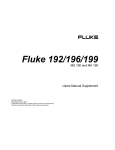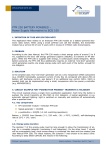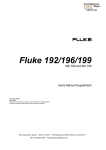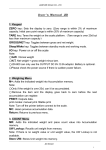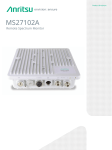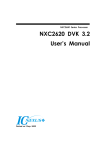Download AN0504 Tag Design with swarm bee LE
Transcript
Application Note AN0504 Tag Design with swarm bee LE Version: 1.2 Author: JDI AN0504 Tag Design with swarm bee LE 1.2 NA-14-0267-0005-1.2 Application Note AN0504 Tag Design with swarm bee LE Version: 1.2 Author: JDI Document Information Document Title: AN0504 Tag Design with swarm bee LE Document Version: 1.2 Current Date: 2015-11-02 Print Date: 2015-11-02 Document ID: NA-14-0267-0005-1.2 Document Author: JDI Disclaimer Nanotron Technologies GmbH believes the information contained herein is correct and accurate at the time of release. Nanotron Technologies GmbH reserves the right to make changes without further notice to the product to improve reliability, function or design. Nanotron Technologies GmbH does not assume any liability or responsibility arising out of this product, as well as any application or circuits described herein, neither does it convey any license under its patent rights. As far as possible, significant changes to product specifications and functionality will be provided in product specific Errata sheets, or in new versions of this document. Customers are encouraged to check the Nanotron website for the most recent updates on products. Trademarks All trademarks, registered trademarks, and product names are the sole property of their respective owners. This document and the information contained herein is the subject of copyright and intellectual property rights under international convention. All rights reserved. No part of this document may be reproduced, stored in a retrieval system, or transmitted in any form by any means, electronic, mechanical or optical, in whole or in part, without the prior written permission of Nanotron Technologies GmbH. Copyright © 2015 Nanotron Technologies GmbH. Page 2 Doc ID NA-14-0267-0005-1.2 © 2015 All Rights Reserved Application Note AN0504 Tag Design with swarm bee LE Version: 1.2 Author: JDI Contents 1. Introduction ............................................................................................................................................... 5 2. Tag Building Blocks .................................................................................................................................. 6 2.1. Antenna .............................................................................................................................................. 6 2.1.1. Chip Antenna ............................................................................................................................... 6 2.1.2. U.FL Standard Connector ............................................................................................................ 7 2.2. Transceiver......................................................................................................................................... 8 2.3. Optional Host...................................................................................................................................... 8 2.3.1. Basic Tag Functionality ................................................................................................................ 8 2.3.2. Extended Tag Functionality with a Host Microcontroller .............................................................. 8 2.4. Power Supply ..................................................................................................................................... 8 2.4.1. Logic Levels ................................................................................................................................. 8 2.5. Housing .............................................................................................................................................. 8 3. Utilizing swarm bee as a Tag .................................................................................................................... 9 3.1. Tag without Host Controller ................................................................................................................ 9 3.2. Tag with Host Controller ..................................................................................................................... 9 4. Power Management ................................................................................................................................ 10 4.1. Power Modes ................................................................................................................................... 10 4.2. Calculating Power Consumption ...................................................................................................... 10 4.3. Battery Lifetime ................................................................................................................................ 10 4.3.1. Collaborative Location (Ranging) ............................................................................................... 10 4.3.2. Fixed Location (TDOA) .............................................................................................................. 11 4.3.3. Combined Location Modes ........................................................................................................ 11 4.4. Battery Monitoring ............................................................................................................................ 12 5. Module Dimension & Soldering Information ............................................................................................ 13 5.1. Module Dimension ............................................................................................................................ 13 5.2. Footprint ........................................................................................................................................... 13 5.3. Recommended Landing Pattern ....................................................................................................... 14 5.4. Soldering Information ....................................................................................................................... 14 6. Firmware Update .................................................................................................................................... 15 7. References.............................................................................................................................................. 16 © 2015 All Rights Reserved Doc ID: NA-14-0267-0005-1.2 Page 3 Application Note AN0504 Tag Design with swarm bee LE Version: 1.2 Author: JDI List of Figures Figure 2-1 general building blocks of a swarm bee tag ................................................................................. 6 Figure 2-2 chip antenna on a two-layer PCB ................................................................................................ 6 Figure 2-3 sample matching network of chip antenna................................................................................... 7 Figure 2-4 U.FL connector on a PCB ............................................................................................................ 7 Figure 3-1 autonomous tag without host controller ....................................................................................... 9 Figure 3-2 tag with host controller ................................................................................................................. 9 Figure 4-1 collaborative location of swarm bee tags ................................................................................... 10 Figure 4-2 fixed location of a swarm bee tag .............................................................................................. 11 Figure 4-3 connection of a voltage divider to swarm bee LE ...................................................................... 12 Figure 5-1 swarm bee LE module, dimensions ........................................................................................... 13 Figure 5-2 swarm bee LE module, footprint ................................................................................................ 13 Figure 5-3 swarm bee LE module – footprint and landing pattern (top view) .............................................. 14 Page 4 Doc ID NA-14-0267-0005-1.2 © 2015 All Rights Reserved Application Note AN0504 Tag Design with swarm bee LE Version: 1.2 Author: JDI 1. Introduction The swarm bee LE CSS radio module is a fully integrated wireless node. The module works both in applications with collaborative location technology based on TOF (ranging) and fixed location technology based on TDOA (time difference of arrival) and supports concurrent communication. This application note describes the necessary steps to create tag designs utilizing the swarm bee LE module. It explains how to utilize nanotron’s new swarm bee LE radio module to build smart tags with host controller and basic tags without host controller. Circuit diagrams for both architectures are shown and could easily be replicated by the user for rapid prototyping and quick time to market. Design recommendations are provided with regards to antenna design, power management and mechanical design. Calculation examples help to estimate battery life depending on application specific parameters like the location blink rate. © 2015 All Rights Reserved Doc ID: NA-14-0267-0005-1.2 Page 5 Application Note AN0504 Tag Design with swarm bee LE Version: 1.2 Author: JDI 2. Tag Building Blocks A swarm bee tag, as shown in Figure 2-1, mainly comprises the following blocks: antenna, transceiver, optional host, power supply and housing. Figure 2-1 general building blocks of a swarm bee tag 2.1. Antenna The swarm bee RF interface is a standard 50 Ohm RF-port which requires a 50 Ohm load for optimal RF performance. It is possible to connect antennas via RF connectors like U.FL as well as printed PCB antennas or chip antennas. The RF port is DC-decoupled. Note: There are specialized companies who can help with specific antenna designs. In case you need to optimize your antenna solution while meeting certain mechanical constraints you may want to consult with them. 2.1.1. Chip Antenna There are a lot of manufacturers who provide 2.4 GHz chip antenna, for example Antenova, Murata, Taiyo Yuden, TDK, Yageo, Johanson, etc. Figure 2-2 shows a chip antenna from Johanson, type 2450AT43A100. Figure 2-2 chip antenna on a two-layer PCB A chip antenna needs to create a 50 Ohm load impedance. The matching networks can be usually found in the data sheet of the chip antenna. A “T” matching network is widely used to meet most application requirements, see Figure 2-3. Please pay attention to the following during design of antenna matching circuit: Page 6 Doc ID NA-14-0267-0005-1.2 © 2015 All Rights Reserved Application Note AN0504 Tag Design with swarm bee LE Version: 1.2 Author: JDI Figure 2-3 sample matching network of chip antenna - It is recommended to choose “low-pass”, i.e. Z1 and Z3 as inductor and Z2 as capacitor. The typical range of inductor is 1 nH … 8.2 nH, and as for capacitor 0.2 pF … 2.7 pF. If serial matching components Z1 and Z3 are not needed, they can be replaced by 0 R resistors. If Z2 is not needed, it must be left open. The leading line to the antenna must have a 50 Ohm impedance. It is recommended to use special RF components with SMD type, the size of which should not be larger than 0402 (metric code). The PCB material and layout must be taken into consideration. It is recommended to measure the related parameters in an RF-Lab to get an optimized design. Certain area surrounding the antenna must be free of circuitry. Generally, the minimum is 3 mm, see Figure 2-2 for example (The dimensions are in mm.). 2.1.2. U.FL Standard Connector Alternatively, an external antenna can be chosen for the swarm bee tag. It can bee connected to swarm bee LE module through a 2.4 GHz RF-connector on the carrier board of the module. A widely used connector of this kind is a U.FL-R-SMT connector, see Figure 2-4. A proper RF-cable must be chosen to connect an antenna via U.FL connector. Pay attention to the following when using U.FL connectors: - The leading line from swarm bee LE module to U.FL connector must be as short as possible; The leading line must have a 50 Ohm impedance; The leading line must be embedded in GROUND; No signal lines shall run in the PCB layer directly under the connector; Adjacent ground planes in different PCB layers must be connected with as many vias as possible; The ground frames surrounding the U.FL connector must be at least 5 mm away from the via lines. The area of the layer directly under the U.FL connector must be designed as GROUND. Figure 2-4 shows a U.FL connector with a curved leading line on a PCB. Figure 2-4 U.FL connector on a PCB © 2015 All Rights Reserved Doc ID: NA-14-0267-0005-1.2 Page 7 Application Note AN0504 Tag Design with swarm bee LE Version: 1.2 Author: JDI 2.2. Transceiver In each swarm bee LE module, the key block of a swarm bee tag, there is a nanoLOC TRX transceiver chip based on nanotron’s CSS (Chirp Spread Spectrum) technology. The nanoLOC integrated circuit operates in the freely accessible 2.4 GHz ISM band. Please refer to [1] for more information about the nanoLOC transceiver. 2.3. Optional Host The swarm bee LE module supports a number of basic tag functionalities like periodical transmission of Node ID broadcast. To utilize the basic tag functionality the module can be operated in stand-alone mode, as shown in Figure 3-1. If extended tag functionality is required, swarm bee LE should be used in conjunction with a host microcontroller. Using a microcontroller also provides more flexibilty to configure the tag for different modes of operation. In most cases, the performance of a small low-power 8-bit controller will be sufficient. The configuration as a tag with or without controller is done by pulling pin 4 A_MODE of swarm bee LE to ground or leaving it open (set A_MODE to HIGH)) respectively. Please refer to Figure 3-2. Note: With the latest swarm firmware (from V2.1.1 onwards) it is still possible to use UART when A_MODE is set to HIGH. In this case, UART wakes up periodically together with the device. 2.3.1. Basic Tag Functionality Tags based on a stand-alone swarm bee LE module are suitable for collaborative and fixed location applications. They are able to transmit location broadcasts and respond to ranging requests. Most recent readings from the on-board MEMS and temperature sensor are transmitted in each of the location broadcasts as payload. Please refer to [3] for a complete list of pre-set parameters. The tag can be powered down periodically by pulling MOD_EN low (Figure 3-1). 2.3.2. Extended Tag Functionality with a Host Microcontroller Together with a host microcontroller the swarm bee LE module offers several location, communication and configuration options beyond the basic tag functionality. In this configuration a tag user interface – for instance a buzzer and/or push buttons – can be implemented. 2.4. Power Supply swarm bee LE supports the supply voltage range between 3.0 V and 5.5 V. Direct supply from primary or rechargeable batteries is possible as well as external supply via USB. 2.4.1. Logic Levels Regardless of the power supply voltages of swarm bee LE and host, the digital signal levels from host and module are subject to the following restrictions (relative to the swarm bee LE module): - - VIL (input voltage low): VIH (input voltage high): VOL (output voltage low): VOH (output voltage high): FT Input (five-volt tolerant input): max. 0.7 V max. 2.8 V max. 0.45 V min. 2.15 V max. 5.5 V For pin configuration and supply voltage range of swarm bee LE please refer to [2]. If host and module work from different supplies level shifters might be necessary. 2.5. Housing The swarm bee LE module together with an optional host is usually mounted onto a carrier board, which (including or excluding power supply) is then put into a housing to build a tag. Operating conditions such as temperature, humidity etc. must be taken into consideration to choose the right material of the housing. Page 8 Doc ID NA-14-0267-0005-1.2 © 2015 All Rights Reserved Application Note AN0504 Tag Design with swarm bee LE Version: 1.2 Author: JDI 3. Utilizing swarm bee as a Tag According to application requirements, a swarm bee tag can be designed as a tag without host controller or as a smart tag with an external host controller. 3.1. Tag without Host Controller Figure 3-1 shows a possible configuration of swarm bee tag for stand-alone operation with a (chip) antenna. When an external host is connected, i.e. for debugging purpose, the same signal level restrictions are valid as for tag configuration with internal host. Figure 3-1 autonomous tag without host controller Note: for a full list of pin description (MOD_EN, UART_TX etc.), please refer to [3]. 3.2. Tag with Host Controller Figure 3-2 shows a possible configuration of swarm bee as a tag with host. The power supply voltage range for swarm bee must be within 3 V … 5.5 V. The host may have the same or a different power supply voltage. Important are the correct levels of digital signals between swarm bee and the host. By pulling pin 6 (MOD_EN) to logical LOW, the swarm bee LE module can be completely disabled. In this case, the module draws a current of less than 1uA. The swarm bee LE module can be enabled by setting pin 6 to HIGH with a level from 1.5 V to VDD of swarm bee. Note: Pin 6 MOD_EN must never be left open. A pull-down resistor should be connected to it. The value of this resistor should not be higher than 10% of the internal pull-up resistor connected to pin 6. Figure 3-2 tag with host controller © 2015 All Rights Reserved Doc ID: NA-14-0267-0005-1.2 Page 9 Application Note AN0504 Tag Design with swarm bee LE Version: 1.2 Author: JDI 4. Power Management The swarm bee LE module can go to sleep and only wake up periodically for a short time in order to save battery power. The underlying power management concept enables cooperation between the radios of a larger swarm even if they sleep most of the time. 4.1. Power Modes With regards to its power consumption a swarm bee LE module can be used either managed or unmanaged. There are three different power modes which are controlled by hardware and software simultaneously, see Table 4-1. Table 4-1 Power Modes of swarm bee LE For a detailed description of the power modes, please refer to [3]. 4.2. Calculating Power Consumption Power consumption depends on the tag design, the use of power modes, the location update rate and the location method adopted. Power consumption varies for different application scenarios. 4.3. Battery Lifetime The battery lifetime of a stand-alone tag can be calculated when power consumption is known and the battery capacity is given. In the following a sample calculation is shown for typical location sequences. 4.3.1. Collaborative Location (Ranging) swarm bee tags can be used for collaborative location (as shown in Figure 4-1) where one moving tag ranges with one or more other moving or fixed tags in its neighbourhood. Local anchors which have received ranging results forward them to the location server which calculates the accurate location of the tag. Figure 4-1 collaborative location of swarm bee tags When a swarm bee tag only ranges to one other tag, the energy consumption for a ranging cycle has been measured as about 1200 µAs, when the board is working in in 80MHz. If the ranging interval is 10 s, the Page 10 Doc ID NA-14-0267-0005-1.2 © 2015 All Rights Reserved Application Note AN0504 Tag Design with swarm bee LE Version: 1.2 Author: JDI battery capacity 1200 mAh and the battery efficiency 90%, the approximate battery lifetime T1 can be calculated as follows: T1 = 1200 𝑚𝐴ℎ∗ 90 % 1200 µ𝐴𝑠 /10 𝑠 = 9000 h When a swarm bee tag ranges to more than one tags, the energy consumption for a ranging cycle would be increased by about 300 µAs per tag. If the other paramters are not changed, the approximate battery lifetime T2 for ranging to two tags can be calculated as follows: T2 = 1200 𝑚𝐴ℎ∗ 90 % (1200+300) µ𝐴𝑠 /10 𝑠 = 7200 h Similarly, the approximate battery lifetime T3 for ranging to three tags can be calculated as follows: T3 = 1200 𝑚𝐴ℎ∗ 90 % (1200+300∗2) µ𝐴𝑠 /10 𝑠 = 6000 h Ranging with just one tag provides proximity information only, ranging values from two tags can be used to determine lateral location information and ranging with three reference tags allows to calculate a 2D location value. Note: To simplify the approximate calculation, the power down consumption has been neglected. For an accurate calculation of the battery lifetime, this parameter must be considered. Specifically for long ranging intervalls this component might even dominate. 4.3.2. Fixed Location (TDOA) swarm bee tags can be used for fixed location as well, see Figure 4-2. During fixed location, a moving tag sends out its node ID blink regularly. Anchors on fixed points receive the blinks and forward them to the location server which calculates the location of the tag based on TDOA (time difference of arrival). Figure 4-2 fixed location of a swarm bee tag For this application the power consumption of a tag mostly depends on the blink interval and it is much lower than in collaborative location. The measured value for each blink is about 900 µAs. If the blink interval is 1 s, the battery capacity 1200 mAh and the battery efficiency 90%, the approximate battery lifetime T4 can be calculated as follows: T4 = 1200 𝑚𝐴ℎ∗ 90 % 900 µ𝐴𝑠 /1 𝑠 = 1200 h Note: To simplify the approximate calculation, the power down consumption has been neglected. For an accurate calculation of the battery lifetime, this parameter must be considered. It dominates for long phases of sleep between blinks. 4.3.3. Combined Location Modes Depending on requirements of an application, swarm bee tags may be used for combined location modes, i.e. in areas where relative location information is needed between radio nodes, a tag must range with other © 2015 All Rights Reserved Doc ID: NA-14-0267-0005-1.2 Page 11 Application Note AN0504 Tag Design with swarm bee LE Version: 1.2 Author: JDI tags in order to avoid collisions or dangers. In other areas, a tag may just need to send its own node ID blink so that the server can detect the position of this tag. In this case, the battery lifetime of a tag can be calculated combining parameters for both collaborative and fixed location. 4.4. Battery Monitoring In order to monitor the battery voltage level, the voltage can be read out through a voltage divider which is connected to Pin 24 of the module, as shown in Figure 4-3. Two resistors of 2.2 MΩ and 2.7 MΩ are required for the circuit. 2.7 MΩ must be connected to VIN (battery voltage, 3 ~ 5.5 V) and 2.2 MΩ to GND. Depending on battery voltage, there is a permanent power consumption over the voltage divider with a little less than 1µA. To avoid wrong results of battery value, this voltage divider with the two resistors mentioned above must be used. If it is not necessary for the user to get the voltage value, the voltage divider may be spared. In this case, the Pin 24 must be connected to GND permanently. If Pin 24 is left open, any values can be read out as battery voltage values, which are wrong values. Figure 4-3 connection of a voltage divider to swarm bee LE Note: For a full list of pin description (e.g. GPIO pins), please refer to [3]. Page 12 Doc ID NA-14-0267-0005-1.2 © 2015 All Rights Reserved Application Note AN0504 Tag Design with swarm bee LE Version: 1.2 Author: JDI 5. Module Dimension & Soldering Information 5.1. Module Dimension Figure 5-1 swarm bee LE module, dimensions 5.2. Footprint Figure 5-2 swarm bee LE module, footprint © 2015 All Rights Reserved Doc ID: NA-14-0267-0005-1.2 Page 13 Application Note AN0504 Tag Design with swarm bee LE Version: 1.2 Author: JDI 5.3. Recommended Landing Pattern The same dimensions for the solder paste screen are recommended, depending on the solder screen thickness. Figure 5-3 swarm bee LE module – footprint and landing pattern (top view) 5.4. Soldering Information For lead-free reflow soldering, the following conditions are recommended: - - max. Solder Peak Temperature: 200°C Solder Paste: for example ALPHA® CVP-520 Page 14 Doc ID NA-14-0267-0005-1.2 © 2015 All Rights Reserved Application Note AN0504 Tag Design with swarm bee LE Version: 1.2 Author: JDI 6. Firmware Update The swarm bee LE module is delivered with the latest firmware. An update of the firmware is possible through the host interface, see [4] for more information. © 2015 All Rights Reserved Doc ID: NA-14-0267-0005-1.2 Page 15 Application Note AN0504 Tag Design with swarm bee LE Version: 1.2 Author: JDI 7. References [1] [2] [3] [4] nanoLOC Data Sheet, V2.01 as of 23.04.2008, Doc ID: NA-06-0230-0388-2.01 swarm bee LE Data Sheet, V1.2 as of 10.04.2015 , Doc ID: NA-14-0267-0002-1.2 swarm API V2.2 as of 08.10.2015, Doc ID: NA-13-0267-0003-2.2 swarm bee LE Firmware Update User Guide, V1.0 as of 27.10.2014, Doc ID: NA-14-0267-00091.0 Page 16 Doc ID NA-14-0267-0005-1.2 © 2015 All Rights Reserved Application Note AN0504 Tag Design with swarm bee LE Version: 1.2 Author: JDI End of Document © 2015 All Rights Reserved Doc ID: NA-14-0267-0005-1.2 Page 17 Application Note AN0504 Tag Design with swarm bee LE Version: 1.2 Author: JDI Document History Date Authors Version 2014.09.30 JDI 1.0 Initial version. 2015.04.10 JDI 1.1 Battery monitoring added; power saving mode updated. 2015.11.02 JDI 1.2 Design hints for chip antenna (chapter 2.1.1) added. Power modes added. Typos corrected. Page 18 Doc ID NA-14-0267-0005-1.2 Description © 2015 All Rights Reserved Application Note AN0504 Tag Design with swarm bee LE Version: 1.2 Author: JDI Life Support Policy These products are not designed for use in life support appliances, devices, or systems where malfunction of these products can reasonably be expected to result in personal injury. Nanotron Technologies GmbH customers using or selling these products for use in such applications do so at their own risk and agree to fully indemnify Nanotron Technologies GmbH for any damages resulting from such improper use or sale. Electromagnetic Interference / Compatibility Nearly every electronic device is susceptible to electromagnetic interference (EMI) if inadequately shielded, designed, or otherwise configured for electromagnetic compatibility. To avoid electromagnetic interference and/or compatibility conflicts, do not use this device in any facility where posted notices instruct you to do so. In aircraft, use of any radio frequency devices must be in accordance with applicable regulations. Hospitals or health care facilities may be using equipment that is sensitive to external RF energy. With medical devices, maintain a minimum separation of 15 cm (6 inches) between pacemakers and wireless devices and some wireless radios may interfere with some hearing aids. If other personal medical devices are being used in the vicinity of wireless devices, ensure that the device has been adequately shielded from RF energy. In a domestic environment this product may cause radio interference in which case the user may be required to take adequate measures. CAUTION - Electrostatic Sensitive Device! Precaution should be used when handling the device in order to prevent permanent damage. FCC User Information Statement according to FCC part 15.19: This device complies with Part 15 of the FCC Rules. Operation is subject to the following two conditions: (1) this device may not cause harmful interference, and (2) this device must accept any interference received, including interference that may cause undesired operation. Statement according to FCC part 15.21: Modifications not expressly approved by this company could void the user's authority to operate the equipment. RF exposure: The internal / external antennas used for this mobile transmitter must provide a separation distance of at least 20 cm from all persons and must not be co-located or operating in conjunction with any other antenna or transmitter. Statement according to FCC part 15.105: This equipment has been tested and found to comply with the limits for a Class A and Class B digital device, pursuant to Part 15 of the FCC Rules. These limits are designed to provide About Nanotron Technologies GmbH Nanotron provides reliable loss protection technology and solutions that are used to protect people and animals. Energy efficient, batterypowered wireless nodes are the key building blocks. These small devices create a Virtual Safety Zone which protects tagged people and animals. Robust wireless Chirp technology underpins nanotron’s offering of chips, modules and loss protection software for indoor and outdoor environments world wide. reasonable protection against harmful interference in a residential installation and against harmful interference when the equipment is operated in a commercial environment. This equipment generates, uses, and can radiate radio frequency energy and, if not installed and used in accordance with the instructions as provided in the user manual, may cause harmful interference to radio communications. However, there is no guarantee that interference will not occur in a particular installation. Operation of this equipment in a residential area is likely to cause harmful interference in which case the user will be required to correct the interference at his or her own expense. If this equipment does cause harmful interference to radio or television reception, which can be determined by turning the equipment off and on, the user is encouraged to try to correct the interference by one or more of the following measures: (1) reorient or relocate the receiving antenna, (2) increase the separation between the equipment and receiver, (3) connect the equipment into an outlet on a circuit different from that to the connected equipment, and (4) consult the dealer or an experienced technician for help. Headquartered in Berlin, Germany, Nanotron Technologies GmbH was founded in 1991 and is an active member of IEEE. Further Information For more information about products from Nanotron Technologies GmbH, contact a sales representative at the following address: Nanotron Technologies GmbH Alt-Moabit 60 10555 Berlin, Germany Phone: +49 30 399 954 – 0 Fax: +49 30 399 954 – 188 Email: sales@nanotron.com Internet: www.nanotron.com



















